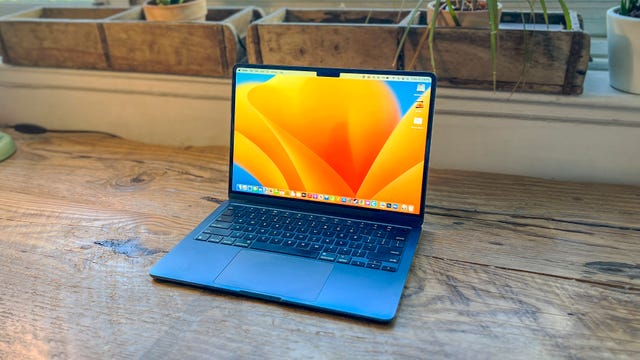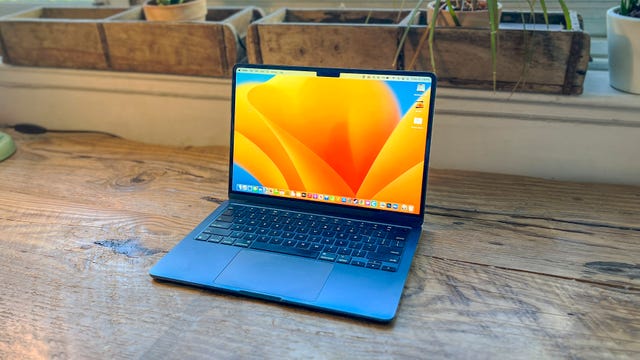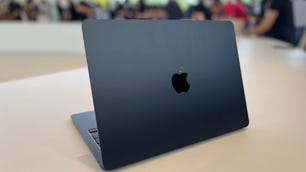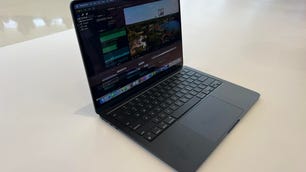 Why You Can Trust CNET
Why You Can Trust CNET
Experts
Tests per laptop
Hours testing
CNET’s expert staff reviews and rates dozens of new products and services each month, building on more than a quarter century of expertise.
What’s the best HP laptop overall?
Our top pick is the HP Dragonfly Pro. It’s the closest Windows laptop we’ve tested to a MacBook Pro in terms of overall design and build quality. It’s really stunning. And it costs hundreds of dollars less than a MacBook Pro. I wish you could bump the display up in resolution a notch or two, and while I like getting a year of dedicated and complimentary support, I certainly don’t need four dedicated hotkeys to access it. Those quibbles aside, the Dragonfly Pro is a compelling package if you need a Windows laptop but also desire a fit and finish that’s on par with that from Apple. The Dragonfly Pro Chromebook is also excellent.
Beyond the Dragonfly Pro, HP offers a wide array of models, from the entry-level HP Laptop and mainstream Pavilion lines to higher-end Envy and premium Spectre models. And for gamers, there’s budget Victus and premium Omen gaming laptops. Year after year, we have reviewed every type of HP laptop, performing benchmark testing under controlled conditions in the CNET Labs and conducting extensive hands-on tests to thoroughly evaluate each product. With decades of experience, CNET’s laptops experts have done the testing and research to find the best laptops that HP has to offer. And here they are.
Best MacBook alternative
HP Dragonfly Pro
The 14-inch Dragonfly Pro is a MacBook alternative that boasts a similarly clean and rigid design and targets the same mainstream “pro” users. And priced at a reasonable $1,400, it costs hundreds less than the 14-inch MacBook Pro. You may not use its gimmicky hotkeys that connect you to HP support, but you will undoubtedly love the look and feel of this minimalistic, matte-black laptop. And it’s more than just a pretty face. It offers competitive performance with its Ryzen 7 7736U processor and also supplies a high-res 1440p webcam and quad speakers that deliver rich, full sound. The Dragonfly Pro is about as close as you can get to a MacBook Pro in a Windows laptop.
- Gorgeous, understated design
- Rock-solid chassis
- One year of 24/7 support
- High-res 1440p webcam
- Speakers sound great
- Display resolution is merely adequate
- HP support hotkeys feel gimmicky
- Paltry port selection
The 14-inch Dragonfly Pro is a MacBook alternative that boasts a similarly clean and rigid design and targets the same mainstream “pro” users. And priced at a reasonable $1,400, it costs hundreds less than the 14-inch MacBook Pro. You may not use its gimmicky hotkeys that connect you to HP support, but you will undoubtedly love the look and feel of this minimalistic, matte-black laptop. And it’s more than just a pretty face. It offers competitive performance with its Ryzen 7 7736U processor and also supplies a high-res 1440p webcam and quad speakers that deliver rich, full sound. The Dragonfly Pro is about as close as you can get to a MacBook Pro in a Windows laptop.

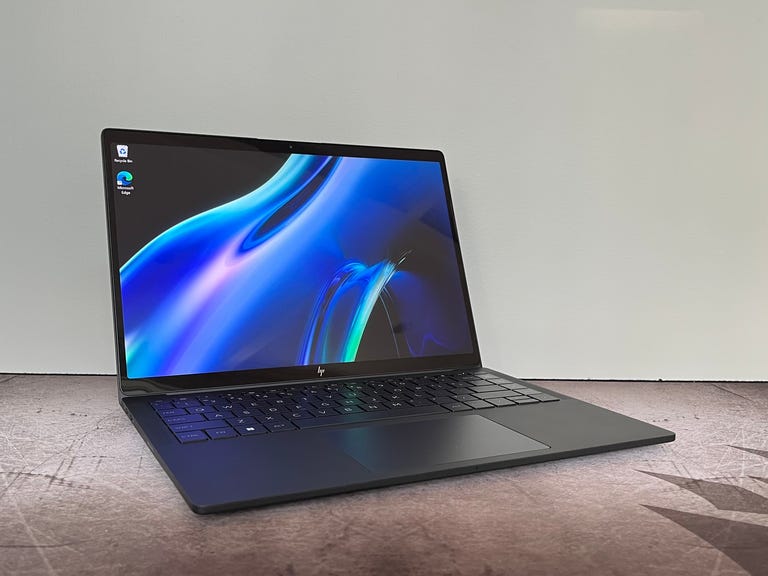
Best MacBook alternative
HP Dragonfly Pro


- Gorgeous, understated design
- Rock-solid chassis
- One year of 24/7 support
- High-res 1440p webcam
- Speakers sound great
- Display resolution is merely adequate
- HP support hotkeys feel gimmicky
- Paltry port selection
The 14-inch Dragonfly Pro is a MacBook alternative that boasts a similarly clean and rigid design and targets the same mainstream “pro” users. And priced at a reasonable $1,400, it costs hundreds less than the 14-inch MacBook Pro. You may not use its gimmicky hotkeys that connect you to HP support, but you will undoubtedly love the look and feel of this minimalistic, matte-black laptop. And it’s more than just a pretty face. It offers competitive performance with its Ryzen 7 7736U processor and also supplies a high-res 1440p webcam and quad speakers that deliver rich, full sound. The Dragonfly Pro is about as close as you can get to a MacBook Pro in a Windows laptop.
Best HP mainstream laptop
HP Pavilion 14
The HP Pavilion 14 is a budget laptop that looks and performs above its price. At 3.2 pounds (1.4 kilograms), the laptop can easily be a daily carry for school or work. It could also be a good home office laptop that can be easily connected to a monitor, keyboard and mouse at a desk, but it also has a screen that’s comfortably large enough for full-time use. It’s just a solid everyday laptop with a clean design. The 12th-gen Core i5 CPU is a generation behind Intel’s current lineup, but we like getting 16GB of RAM, which is double the amount you sometimes find at this price. You can usually find it discounted from its full $800 price, and right now it’s a great value at its sale price of $580.
- Many configuration options including discrete graphics
- Attractive, lightweight design with a good port assortment
- Flex in keyboard deck, lid
- Battery life might disappoint\
The HP Pavilion 14 is a budget laptop that looks and performs above its price. At 3.2 pounds (1.4 kilograms), the laptop can easily be a daily carry for school or work. It could also be a good home office laptop that can be easily connected to a monitor, keyboard and mouse at a desk, but it also has a screen that’s comfortably large enough for full-time use. It’s just a solid everyday laptop with a clean design. The 12th-gen Core i5 CPU is a generation behind Intel’s current lineup, but we like getting 16GB of RAM, which is double the amount you sometimes find at this price. You can usually find it discounted from its full $800 price, and right now it’s a great value at its sale price of $580.
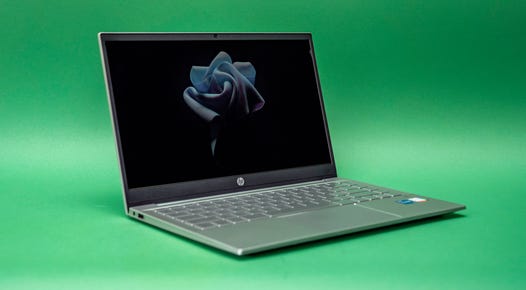
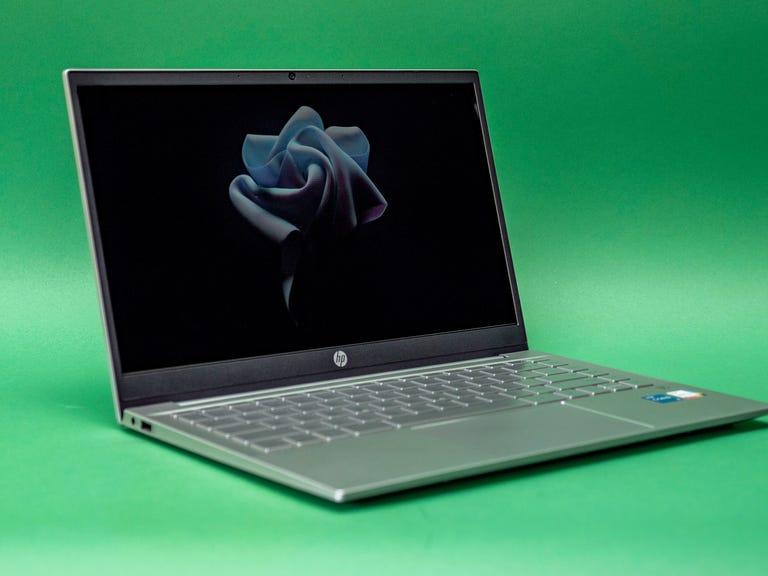
Best HP mainstream laptop
HP Pavilion 14


- Many configuration options including discrete graphics
- Attractive, lightweight design with a good port assortment
- Flex in keyboard deck, lid
- Battery life might disappoint\
The HP Pavilion 14 is a budget laptop that looks and performs above its price. At 3.2 pounds (1.4 kilograms), the laptop can easily be a daily carry for school or work. It could also be a good home office laptop that can be easily connected to a monitor, keyboard and mouse at a desk, but it also has a screen that’s comfortably large enough for full-time use. It’s just a solid everyday laptop with a clean design. The 12th-gen Core i5 CPU is a generation behind Intel’s current lineup, but we like getting 16GB of RAM, which is double the amount you sometimes find at this price. You can usually find it discounted from its full $800 price, and right now it’s a great value at its sale price of $580.
Best HP budget OLED laptop
HP Pavilion Plus 14
Sitting between the meat-and-potatoes Pavilion line and higher-end Envy line, the Pavilion Plus series offers attractive features at affordable prices. At the top of the list of this 14-inch Pavilion Plus model’s attractions is a 2.8K OLED display that offers a stellar contrast ratio, sharp text, vivid colors and a wide color gamut covering 100% DCI-P3 color space. We liked last year’s model that was priced at $1,000, and we like this year’s model that costs $950. You trade the 12th-gen Core i7 part from the model we reviewed last year for a 13th-gen Core i5 chip but get twice the storage capacity with a 512GB SSD. The Pavilion Plus is one of the most affordable OLED laptops.
- Excellent performance, display for its price
- 5-megapixel webcam
- Attractive all-metal body
- OLED display hurts battery life
- Some software bloat
- No camera shutter, mic mute
Sitting between the meat-and-potatoes Pavilion line and higher-end Envy line, the Pavilion Plus series offers attractive features at affordable prices. At the top of the list of this 14-inch Pavilion Plus model’s attractions is a 2.8K OLED display that offers a stellar contrast ratio, sharp text, vivid colors and a wide color gamut covering 100% DCI-P3 color space. We liked last year’s model that was priced at $1,000, and we like this year’s model that costs $950. You trade the 12th-gen Core i7 part from the model we reviewed last year for a 13th-gen Core i5 chip but get twice the storage capacity with a 512GB SSD. The Pavilion Plus is one of the most affordable OLED laptops.

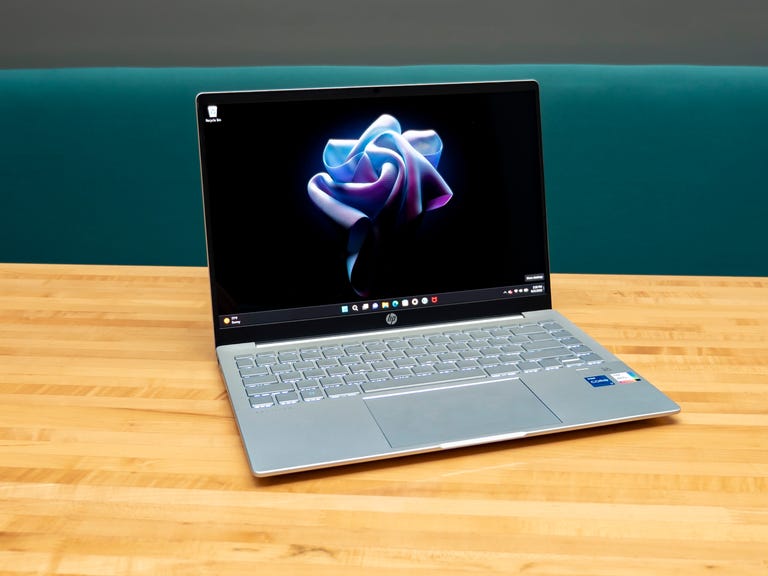
Best HP budget OLED laptop
HP Pavilion Plus 14


- Excellent performance, display for its price
- 5-megapixel webcam
- Attractive all-metal body
- OLED display hurts battery life
- Some software bloat
- No camera shutter, mic mute
Sitting between the meat-and-potatoes Pavilion line and higher-end Envy line, the Pavilion Plus series offers attractive features at affordable prices. At the top of the list of this 14-inch Pavilion Plus model’s attractions is a 2.8K OLED display that offers a stellar contrast ratio, sharp text, vivid colors and a wide color gamut covering 100% DCI-P3 color space. We liked last year’s model that was priced at $1,000, and we like this year’s model that costs $950. You trade the 12th-gen Core i7 part from the model we reviewed last year for a 13th-gen Core i5 chip but get twice the storage capacity with a 512GB SSD. The Pavilion Plus is one of the most affordable OLED laptops.
Best HP laptop for students
HP Pavilion Aero 13
HP packed a lot of value into the Aero 13, from an eye-pleasing magnesium-aluminum chassis and a bright, colorful display to strong processing performance and long battery life. And it weighs just a hair over 2 pounds, making it easy to trek across campus. It’s also easy on the wallet. It’s frequently discounted at HP, and right now it starts at just $500. It’s customizable on HP’s site, and I’d suggest doubling the RAM to 16GB and the SSD to 512GB. Each upgrade costs $60. I’d also spring for the backlit keyboard for an extra $20. With those three upgrades, the total price is still a sensible $640.
- Weighs under 2.2 pounds
- Long battery life
- Excellent performance for everyday tasks
- Backlit keyboard not standard
- No touchscreen option
- Memory is soldered on
HP packed a lot of value into the Aero 13, from an eye-pleasing magnesium-aluminum chassis and a bright, colorful display to strong processing performance and long battery life. And it weighs just a hair over 2 pounds, making it easy to trek across campus. It’s also easy on the wallet. It’s frequently discounted at HP, and right now it starts at just $500. It’s customizable on HP’s site, and I’d suggest doubling the RAM to 16GB and the SSD to 512GB. Each upgrade costs $60. I’d also spring for the backlit keyboard for an extra $20. With those three upgrades, the total price is still a sensible $640.

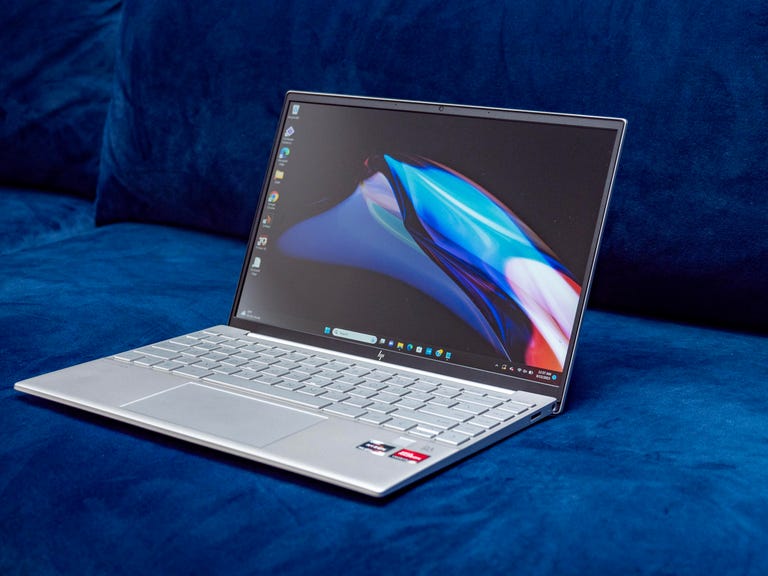
Best HP laptop for students
HP Pavilion Aero 13


- Weighs under 2.2 pounds
- Long battery life
- Excellent performance for everyday tasks
- Backlit keyboard not standard
- No touchscreen option
- Memory is soldered on
HP packed a lot of value into the Aero 13, from an eye-pleasing magnesium-aluminum chassis and a bright, colorful display to strong processing performance and long battery life. And it weighs just a hair over 2 pounds, making it easy to trek across campus. It’s also easy on the wallet. It’s frequently discounted at HP, and right now it starts at just $500. It’s customizable on HP’s site, and I’d suggest doubling the RAM to 16GB and the SSD to 512GB. Each upgrade costs $60. I’d also spring for the backlit keyboard for an extra $20. With those three upgrades, the total price is still a sensible $640.
Best HP budget gaming laptop
HP Victus 16
I reviewed an entry-level Victus 15 model earlier this year that cost $800 and was based on a Core i5-12450H CPU and GTX 1650 graphics. Despite the outdated parts, I argued it was a good pick for first-timers looking for their first gaming laptop because of the low price and the fact that it could frequently be found on sale for even less. The slightly larger Victus 16 offers Nvidia RTX GPUs and is an even better buy at its current discount. For the same $800, which reflects a hefty $350 discount at HP, you can pick up a Victus 16 with RTX 3050 graphics, which are still a generation behind the RTX 40 series but much more capable than the GTX graphics in the model I tested. The Victus 16 is an even more capable budget gaming laptop than the 15-inch model I tested and is a great pick for first-time buyers dipping their toes into 3D gaming waters. The Victus 16 offers a simple and straightforward design and does an effective job of covering all the basics for general use and gaming.
- Solid, smooth performance
- Affordable price for its components
- Crisp display quality
- Flimsy screen hinge
- Disappointing sound quality
I reviewed an entry-level Victus 15 model earlier this year that cost $800 and was based on a Core i5-12450H CPU and GTX 1650 graphics. Despite the outdated parts, I argued it was a good pick for first-timers looking for their first gaming laptop because of the low price and the fact that it could frequently be found on sale for even less. The slightly larger Victus 16 offers Nvidia RTX GPUs and is an even better buy at its current discount. For the same $800, which reflects a hefty $350 discount at HP, you can pick up a Victus 16 with RTX 3050 graphics, which are still a generation behind the RTX 40 series but much more capable than the GTX graphics in the model I tested. The Victus 16 is an even more capable budget gaming laptop than the 15-inch model I tested and is a great pick for first-time buyers dipping their toes into 3D gaming waters. The Victus 16 offers a simple and straightforward design and does an effective job of covering all the basics for general use and gaming.

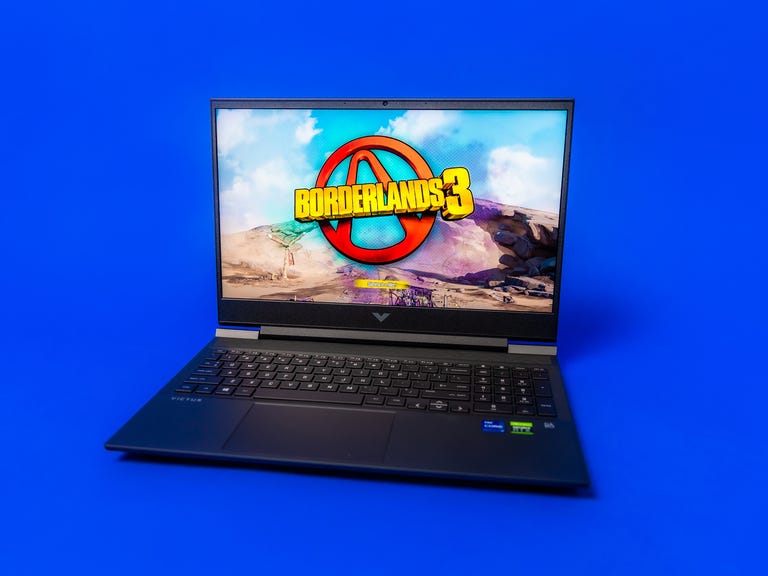
Best HP budget gaming laptop
HP Victus 16


- Solid, smooth performance
- Affordable price for its components
- Crisp display quality
- Flimsy screen hinge
- Disappointing sound quality
I reviewed an entry-level Victus 15 model earlier this year that cost $800 and was based on a Core i5-12450H CPU and GTX 1650 graphics. Despite the outdated parts, I argued it was a good pick for first-timers looking for their first gaming laptop because of the low price and the fact that it could frequently be found on sale for even less. The slightly larger Victus 16 offers Nvidia RTX GPUs and is an even better buy at its current discount. For the same $800, which reflects a hefty $350 discount at HP, you can pick up a Victus 16 with RTX 3050 graphics, which are still a generation behind the RTX 40 series but much more capable than the GTX graphics in the model I tested. The Victus 16 is an even more capable budget gaming laptop than the 15-inch model I tested and is a great pick for first-time buyers dipping their toes into 3D gaming waters. The Victus 16 offers a simple and straightforward design and does an effective job of covering all the basics for general use and gaming.
Best HP laptop with a foldable display
HP Spectre Foldable PC
Billed as a three-in-one PC, this innovative laptop is based on a 17-inch foldable OLED display that can be used as a 12-inch laptop, a 17-inch tablet or a 17-inch all-in-one desktop. And when used as a laptop, you have two ways to position the Bluetooth keyboard. You can have it so the keyboard sits completely on the bottom half of the screen mimicking a 12-inch clamshell laptop, or you can slide the keyboard down a bit to extend the display over the fold for more screen space. The Spectre Foldable PC is quirky and very pricey but also versatile and thoughtfully designed. When viewed as three machines in one, perhaps the lofty price will begin to feel a bit more palatable.
- Excellent screen
- Thoughtful design
- Slick as a complete package
- Expensive
- Slow
- No audio jack or keyboard backlight
- Ports are in odd places in laptop mode
Billed as a three-in-one PC, this innovative laptop is based on a 17-inch foldable OLED display that can be used as a 12-inch laptop, a 17-inch tablet or a 17-inch all-in-one desktop. And when used as a laptop, you have two ways to position the Bluetooth keyboard. You can have it so the keyboard sits completely on the bottom half of the screen mimicking a 12-inch clamshell laptop, or you can slide the keyboard down a bit to extend the display over the fold for more screen space. The Spectre Foldable PC is quirky and very pricey but also versatile and thoughtfully designed. When viewed as three machines in one, perhaps the lofty price will begin to feel a bit more palatable.

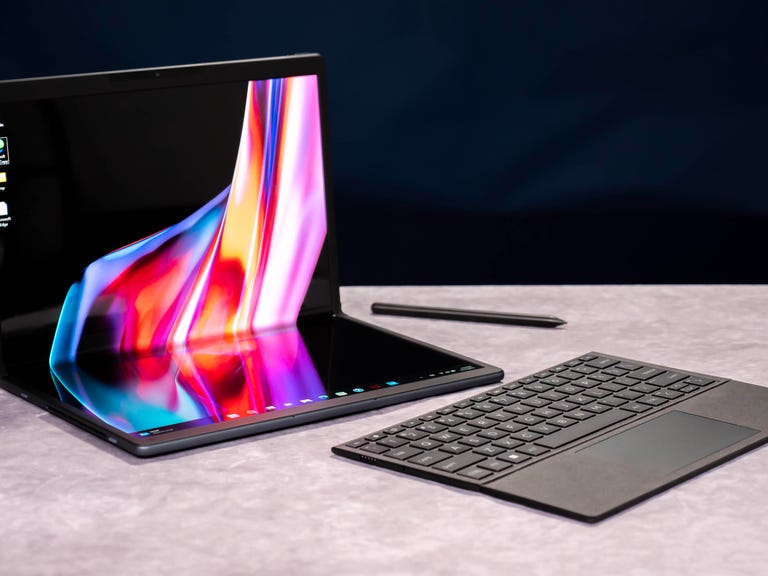
Best HP laptop with a foldable display
HP Spectre Foldable PC


- Excellent screen
- Thoughtful design
- Slick as a complete package
- Expensive
- Slow
- No audio jack or keyboard backlight
- Ports are in odd places in laptop mode
Billed as a three-in-one PC, this innovative laptop is based on a 17-inch foldable OLED display that can be used as a 12-inch laptop, a 17-inch tablet or a 17-inch all-in-one desktop. And when used as a laptop, you have two ways to position the Bluetooth keyboard. You can have it so the keyboard sits completely on the bottom half of the screen mimicking a 12-inch clamshell laptop, or you can slide the keyboard down a bit to extend the display over the fold for more screen space. The Spectre Foldable PC is quirky and very pricey but also versatile and thoughtfully designed. When viewed as three machines in one, perhaps the lofty price will begin to feel a bit more palatable.
Best HP Chromebook
HP Dragonfly Pro Chromebook
For many people, a $1,000 Chromebook defeats the purpose of buying a Chromebook as a cheap alternative to a Windows laptop or MacBook. If you spend the majority, if not the entirety, of your day working via Gmail and Google Drive inside the Chrome browser, however, then the HP Dragonfly Pro Chromebook will hold great appeal. Instead of working on an undersized, flimsy Chromebook, the Dragonfly Pro Chromebook lets you spend each day sitting at a meticulously designed system with a gorgeous display; a fantastic keyboard and touchpad; an unmatched webcam; and ample power and battery life. It’s pricey, but it’s worth every penny.
- Gorgeous design
- Roomy, high-res and bright display
- High-res 8-megapixel webcam
- Comfy keyboard with fun RGB lighting
- Haptic touchpad is awesome
- Punchy quad speakers
- Pricey among Chromebooks
- Previous-gen Intel silicon
- Pen not included
For many people, a $1,000 Chromebook defeats the purpose of buying a Chromebook as a cheap alternative to a Windows laptop or MacBook. If you spend the majority, if not the entirety, of your day working via Gmail and Google Drive inside the Chrome browser, however, then the HP Dragonfly Pro Chromebook will hold great appeal. Instead of working on an undersized, flimsy Chromebook, the Dragonfly Pro Chromebook lets you spend each day sitting at a meticulously designed system with a gorgeous display; a fantastic keyboard and touchpad; an unmatched webcam; and ample power and battery life. It’s pricey, but it’s worth every penny.
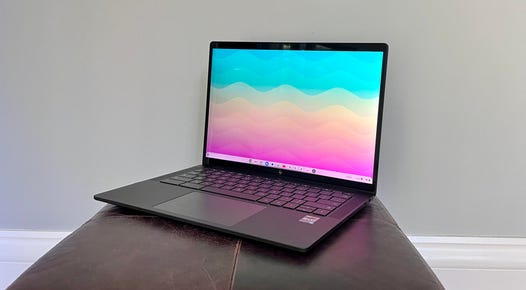
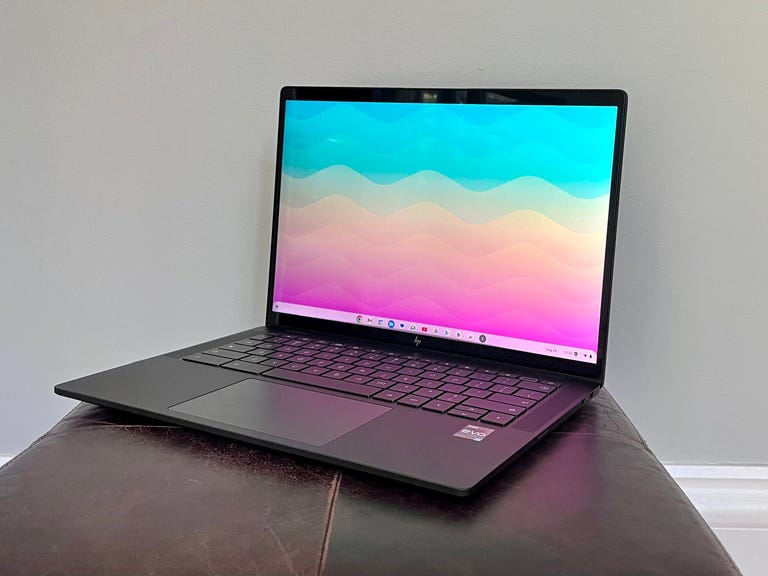
Best HP Chromebook
HP Dragonfly Pro Chromebook


- Gorgeous design
- Roomy, high-res and bright display
- High-res 8-megapixel webcam
- Comfy keyboard with fun RGB lighting
- Haptic touchpad is awesome
- Punchy quad speakers
- Pricey among Chromebooks
- Previous-gen Intel silicon
- Pen not included
For many people, a $1,000 Chromebook defeats the purpose of buying a Chromebook as a cheap alternative to a Windows laptop or MacBook. If you spend the majority, if not the entirety, of your day working via Gmail and Google Drive inside the Chrome browser, however, then the HP Dragonfly Pro Chromebook will hold great appeal. Instead of working on an undersized, flimsy Chromebook, the Dragonfly Pro Chromebook lets you spend each day sitting at a meticulously designed system with a gorgeous display; a fantastic keyboard and touchpad; an unmatched webcam; and ample power and battery life. It’s pricey, but it’s worth every penny.
Best HP budget laptop with big display
HP Laptop 17
For just $650 with HP’s current $270 discount, the HP Laptop 17 provides a portable, reasonably slim body with good performance for home office tasks, entertainment and just general computing. And we had that opinion on the model we reviewed last year that featured an older AMD Ryzen 5 CPU and only 8GB of RAM. Now, that same sum gets you a configuration with a current 13th-gen Core i7 CPU and 16GB of RAM, which almost assuredly will provide better overall performance and return on investment. What’s nice about the 17-inch size is that it’s enough space to work comfortably with multiple windows side by side. It’s a good choice for a family computer — it takes up less room than a full desktop setup, it’s potentially less expensive and it can easily be moved around the house.
- Good performance, battery life
- Many configuration options
- USB-C port can’t be used for power or display output
- No option to add a backlit keyboard
For just $650 with HP’s current $270 discount, the HP Laptop 17 provides a portable, reasonably slim body with good performance for home office tasks, entertainment and just general computing. And we had that opinion on the model we reviewed last year that featured an older AMD Ryzen 5 CPU and only 8GB of RAM. Now, that same sum gets you a configuration with a current 13th-gen Core i7 CPU and 16GB of RAM, which almost assuredly will provide better overall performance and return on investment. What’s nice about the 17-inch size is that it’s enough space to work comfortably with multiple windows side by side. It’s a good choice for a family computer — it takes up less room than a full desktop setup, it’s potentially less expensive and it can easily be moved around the house.

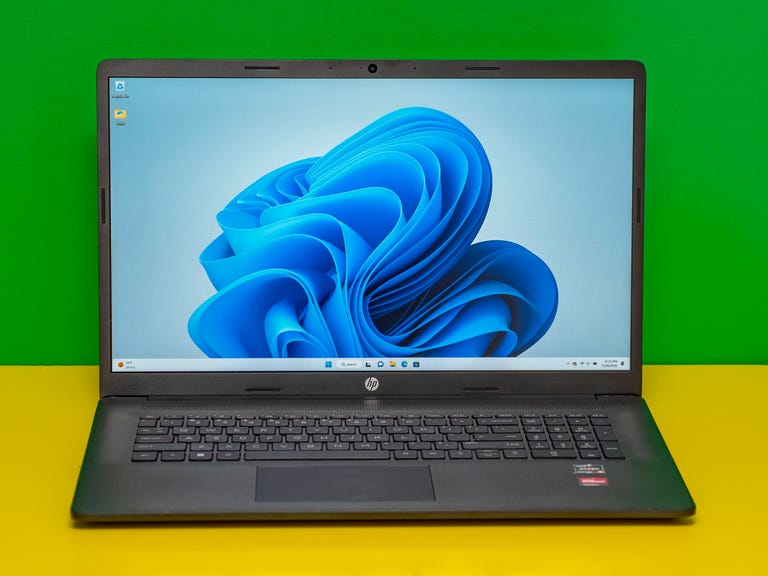
Best HP budget laptop with big display
HP Laptop 17


- Good performance, battery life
- Many configuration options
- USB-C port can’t be used for power or display output
- No option to add a backlit keyboard
For just $650 with HP’s current $270 discount, the HP Laptop 17 provides a portable, reasonably slim body with good performance for home office tasks, entertainment and just general computing. And we had that opinion on the model we reviewed last year that featured an older AMD Ryzen 5 CPU and only 8GB of RAM. Now, that same sum gets you a configuration with a current 13th-gen Core i7 CPU and 16GB of RAM, which almost assuredly will provide better overall performance and return on investment. What’s nice about the 17-inch size is that it’s enough space to work comfortably with multiple windows side by side. It’s a good choice for a family computer — it takes up less room than a full desktop setup, it’s potentially less expensive and it can easily be moved around the house.
Other laptops we’ve tested
Lenovo ThinkPad X1 Carbon Gen 11: The latest X1 Carbon gets 13th-gen Intel processors and greener construction but is otherwise unchanged and remains a top pick for business travelers.
Asus ExpertBook B9450: This 14-inch business ultraportable is impressively light and eminently portable but costs too much when you consider the previous-gen CPU and a display that feels constricted.
LG Gram 17 (2023): The Gram is amazing for its size and weight, but its dGPU is a generation behind, and the price is high.
Lenovo Yoga 7i 16: The 14-inch Yoga 7i has long been a favorite for offering more for less. The “more” on this version includes a 16-inch display with a low resolution that makes text fuzzy and it’s an awkward size for a two-in-one.
Asus ROG G15: Above-average performance and a nice design distinguish this budget gaming laptop from the competition.
Acer Swift X 14: The 14-inch Swift X delivered excellent performance and an OLED display in a small package and with plenty of ports to boot. Its design, keyboard, touchpad and speakers didn’t match the rest of the package.
Lenovo Slim Pro 7: Much like the Acer Swift X, the Slim Pro 7 gets you good performance in a small body, but the other parts aren’t quite as nice.
Asus Vivobook 16X OLED: Outside of its affordability for a big 16-inch OLED display, this Vivobook was a letdown.
Dell XPS 17 9730: The performance and battery life are spot-on, but the lack of an OLED display option and an outdated 720p webcam hold it back.
The best laptops in every category
How we test laptops
The review process for laptops consists of two parts: performance testing under controlled conditions in the CNET Labs and extensive hands-on use by our reviewers. This includes evaluating a device’s aesthetics, ergonomics and features with respect to price. A final review verdict is a combination of both objective and subjective judgments.
We test all laptops with a core set of benchmarks, including Primate Labs Geekbench 5 and 6, Cinebench R23, PCMark 10, a variety of 3DMark benchmarks (whichever can run on the laptop), UL Procyon Photo and Video (where supported), and our own battery life test. If a laptop is intended for gaming, we’ll also run benchmarks from Guardians of the Galaxy, The Rift Breaker (CPU and GPU) and Shadow of the Tomb Raider.
For the hands-on, the reviewer uses it for their work during the review period, evaluating how well the design, features (such as the screen, camera and speakers) and manufacturer-supplied software operate as a cohesive whole. We also place importance on how well they work given their cost and where the manufacturer has potentially made upgrades or trade-offs for its price.
The list of benchmarking software and comparison criteria we use changes over time as the devices we test evolve. You can find a more detailed description of our test methodology on our How We Test Computers page.
Factors to consider
HP sells a wide variety of laptops, and many models are available in multiple configurations to match your performance and budget needs. If you need help finding the right HP laptop, we can help. Here are the main considerations to keep in mind when shopping for a new laptop.
Price
The search for a new laptop for most people starts with price. If the statistics chipmaker Intel and PC manufacturers hurl at us are correct, you’ll be holding onto your next laptop for at least three years. If you can afford to stretch your budget a little to get better specs, do it. And that stands whether you’re spending $500 or more than $1,000. In the past, you could get away with spending less upfront with an eye toward upgrading memory and storage in the future. But laptop makers are increasingly moving away from making components easily upgradable, so again, it’s best to get as much laptop as you can afford from the start.
Generally speaking, the more you spend, the better the laptop. That could mean better components for faster performance, a nicer display, sturdier build quality, a smaller or lighter design from higher-end materials or even a more comfortable keyboard. All of these things add to the cost of a laptop. I’d love to say $500 will get you a powerful gaming laptop, for example, but that’s not the case. Right now, the sweet spot for a reliable laptop that can handle average work, home office or school tasks is between $700 and $800, and a reasonable model for creative work or gaming upwards of about $1,000. The key is to look for discounts on models in all price ranges so you can get more laptop for less. And like other vendors, HP is constantly rotating sales on laptops on its site.
Size
If you’ll be taking your laptop with you to class or work or just down to your local coffee shop most mornings, then you’ll want a smaller and lighter laptop — something with a 13-inch or 14-inch screen. If you’re buying a laptop for your home or work and don’t plan on traveling with it with any great frequency, then it might serve you well to get a larger 15-inch, 16-inch or even 17-inch display that gives you more room to work and play and multitask.
Display
When deciding on a display, there are many considerations: how much you need to display (which is surprisingly more about resolution than screen size), what types of content you’ll be looking at and whether you’ll be using it for gaming or creative endeavors.
You really want to optimize pixel density; that is, the number of pixels per inch the screen can display. Though there are other factors that contribute to sharpness, a higher pixel density usually means sharper rendering of text and interface elements. (You can easily calculate the pixel density of any screen at DPI Calculator if you don’t feel like doing the math, and you can also find out what math you need to do there.) We recommend a dot pitch of at least 100 pixels per inch as a rule of thumb.
Because of the way Windows can scale the display, you’re frequently better off with a higher resolution than you’d think. You can always make things bigger on a high-resolution screen, but you can never make them smaller — to fit more content in the view — on a low-resolution screen. This is why a 4K, 14-inch screen may sound like unnecessary overkill, but may not be if you need to, say, view a wide spreadsheet.
Text and the edges of images can look fuzzy on a lower-resolution display. Look for a Full HD 1,920×1,080-pixel resolution at minimum — or a 1,920×1,200-pixel resolution on laptops with 16:10 aspect ratios that are taller than traditional 16:9 widescreen displays and provide more vertical screen space for work without significantly increasing the footprint. A Quad HD (QHD) resolution of 2,560×1,440 pixels (2,560×1,600 on a 16:10 display) will result in crisper text and images and will likely suffice on a 13- or 14-inch laptop display — you don’t necessarily need a 4K display.
Processor
The processor, aka the CPU, is the brains of a laptop. Intel and AMD are the main CPU makers for Windows laptops. Both offer a staggering selection of mobile processors. Making things trickier, both manufacturers have chips designed for different laptop styles, like power-saving chips for ultraportables or faster processors for gaming laptops. Their naming conventions will let you know what type is used. You can head to Intel’s or AMD’s sites for explanations so you get the performance you want. Generally speaking, though, the faster the processor speed and the more cores it has, the better the performance will be.
Graphics
The graphics processor, or GPU, handles all the work of driving the screen and generating what gets displayed, as well as speeding up a lot of graphics-related (and increasingly, AI-related) operations. For Windows laptops, there are two types of GPUs: integrated (iGPU) or discrete (dGPU). As the names imply, an iGPU is part of the CPU package, while a dGPU is a separate chip with dedicated memory (VRAM) that it communicates with directly, making it faster than sharing memory with the CPU.
Because the iGPU splits space, memory and power with the CPU, it’s constrained by the limits of those. It allows for smaller, lighter laptops, but doesn’t perform nearly as well as a dGPU. In fact, there are some games and creative software that won’t run unless they detect a dGPU or sufficient VRAM. Most productivity software, video streaming, web browsing and other nonspecialized apps will run fine on an iGPU, though.
For more power-hungry graphics needs, like video editing, STEM and design applications as well as gaming, you’ll need a dGPU; there are only two real companies that make them, Nvidia and AMD, with Intel offering some based on the Xe-branded (or the older UHD Graphics branding) iGPU technology in its CPUs.
Memory
For memory, we highly recommend 16GB of RAM, with 8GB being the absolute bare minimum. RAM is where the operating system stores all the data for currently running applications, and it can fill up fast. After that, it starts swapping between RAM and SSD, which is slower. A lot of sub-$500 laptops have 4GB or 8GB, which in conjunction with a slower disk can make for a frustratingly slow Windows laptop experience. Also, many laptops now have the memory soldered onto the motherboard. Most manufacturers disclose this, but if the RAM type is LPDDR, assume it’s soldered and can’t be upgraded.
Some PC makers will solder memory on, however, and also leave an empty internal slot for adding a stick of RAM. You may need to contact the laptop manufacturer or find the laptop’s full specs online to confirm. And check the web for user experiences, because the slot may still be hard to get to, it may require nonstandard or hard-to-get memory or other pitfalls, including voiding the warranty.
Storage
You’ll still find cheaper hard drives in budget laptops and larger hard drives in gaming laptops, but faster solid-state drives have all but replaced hard drives in laptops. They can make a big difference in performance. But not all SSDs are equally speedy, and cheaper laptops typically have slower drives; if the laptop only has only 8GB of RAM, it may end up swapping to that drive and the system may slow down quickly while you’re working.
Get what you can afford, and if you need to go with a smaller drive, you can always add an external drive or two down the road or use cloud storage to bolster a small internal drive. The one exception is gaming laptops: We don’t recommend going with less than a 512GB SSD unless you really like uninstalling games every time you want to play a new game.
Laptop FAQs

How to Get a Free $30 Ahead of Amazon’s Prime Day Sale Next Week
Need some retail therapy? Amazon’s second Prime Day sale of the year is now a few days away. Prime Big Deal Days is set to hit digital shoppers’ screens on Oct. 10 and 11.
Along with its long list of product deals for Prime Day — including some early ones already on sale — Amazon is offering three ways for you to get a bit of cash to spend: uploading photos to Amazon photos, reloading an Amazon gift card, or adding a debit or credit card to Amazon Wallet. Do all three, and you could get a cool extra $30.
Read more: Unlock Prime Day Deals for Free With This Simple Trick
How does the free cash work, and do you need to be an Amazon Prime member to earn it? Read on to learn all about the ways to get free money for Prime Day.
For more on Amazon Prime Day, check out the best early Prime deals that are available now, and how to use Buy with Prime to get great deals on other shopping sites.
Get $15 for uploading pictures to Amazon Photos
Amazon Prime members can get a quick $15 from Amazon without spending anything. Download the app for desktop, iOS or Android. Then upload at least one photo to the service and you’ll qualify for a $15 credit to use during Prime Day.

There are a few important catches, along with the Prime membership requirement. The $15 credit must be used during Prime Day — between the start of the sale at midnight PT (3 a.m. ET) on Oct. 10 and the end at 11:59 p.m. PT on Oct. 11 (2:59 a.m. ET on Oct. 12). The credit can also only be used for Amazon orders of $30 or more.
The $15 bonus only applies to Amazon Prime members uploading to Amazon Photos for the first time. If you’ve used Amazon Photos before, you’re out of luck. And for those looking to get extra cash along with Prime Day deals for free, the offer is not available to Amazon Prime trial members.
Amazon says you’ll get an email confirmation of your $15 within four days of uploading your first photos. The deal expires at 11:59 p.m. PT on Oct. 7.
Add $100 to your Amazon gift card balance for a free $10
If you’re an Amazon Prime member who uses Amazon gift cards, you could be eligible for a free $10 for using to add $100 to your gift card balance. The offer is only available to Amazon Prime members using Amazon Reload for the first time, so not everyone is eligible. .
Get free $5 for adding a credit or debit card to Amazon Wallet
Some Amazon Prime members can get $5 for adding a valid, qualifying credit card or debit card to Amazon Wallet. . The offer is only valid for Visa, Amex or Discover credit or debit cards.
For more on Amazon’s October Prime Big Deal Days, learn how to prepare for Amazon’s October Prime Day and check out the best early Prime Big Deal Days deals to shop right now.
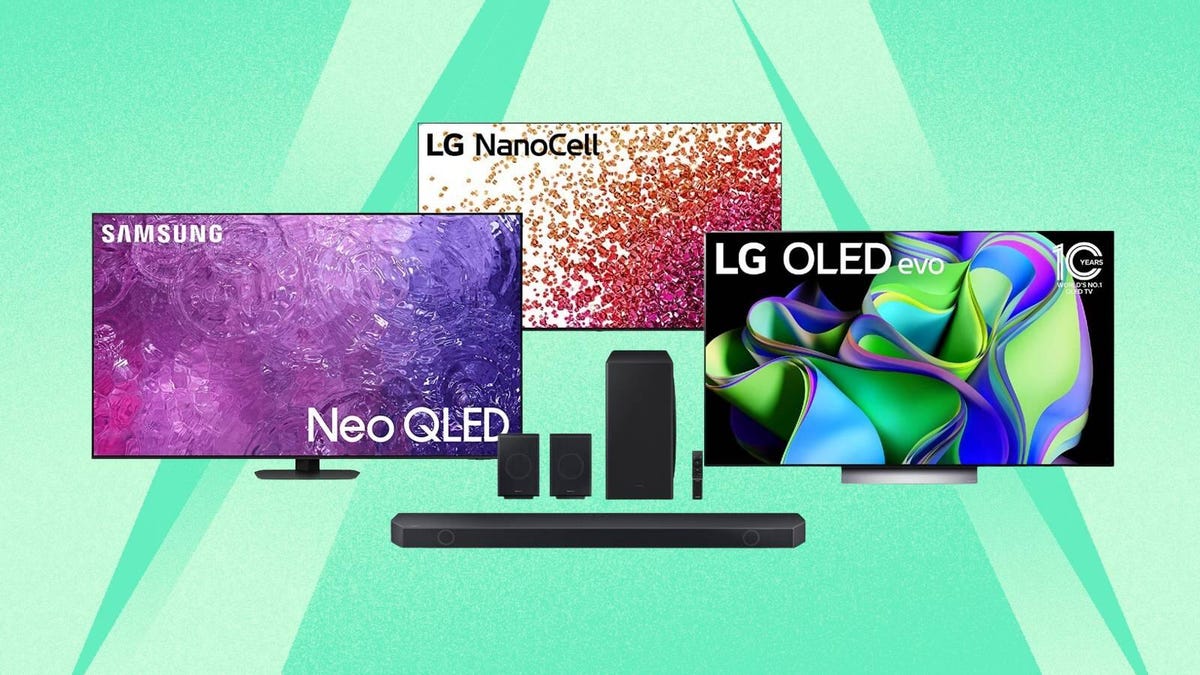
Save Up to 63% During Woot’s Limited-Time TV and Audio Sale
As the weather turns colder, many of us will be spending more time inside. And you can make sure your entertainment area is ready to go without breaking the bank. Right now Woot has slashed prices on new TVs — including impressive OLED models — and soundbars that can boost your audio experience by as much as 63%. These offers are available now through Oct. 9, while supplies last.
If you’re looking for a solid discount on a quality TV, Woot has you covered. You can grab the new 2023 LG C3 Series OLED in 48-, 65-, 77- and 83-inch sizes starting at $1,197. And your purchase comes with a free Visa gift card worth up to $400 in value. For example, the 65-inch model costs $1,797, but you’ll receive a gift card worth $250, so it’s essentially like you’re paying just $1,547 for this top-tier TV that CNET’s David Katzmaier says “sets the standard for high-end TV picture quality.”
Another OLED option is the Samsung S90C Series with Quantum HDR, Dolby Atmos, Object Tracking Sound Lite, built-in Alexa and a gaming hub. The 65-inch model is down to $1,730 — that’s an $868 savings. And for the lowest cost option in the sale, the 43-inch LG NanoCell 75 Series is down to $380 at Woot (save $140). This 4K TV has built-in Alexa and supports HDR, HDR10 and HLG. Plus, it has a Game Optimizer mode with auto low-latency mode, making it a good option for gamers on a budget.
And for audio, there are plenty of great options as well. You can grab the Yamaha SR-B20A soundbar with built-in subwoofers and DTS Virtual: X for $120 right now — that’s an $80 savings. And for an entire sound system to really give your entertainment space a theatrical boost, the 2023 Samsung HW-Q930C 9.1.4 channel system, which includes a wireless Dolby Atmos soundbar, a subwoofer and rear speakers, is a solid choice. It lists for $1,400, but Woot has slashed the price by 50%, so you can get your hands on this audio system for just $698. And something in between the two, Samsung’s HW-S801B Series 3.2.1 channel soundbar and subwoofer set is discounted by 63%, bringing the cost down from $900 to just $335. It has Dolby Atmos and DTS Virtual: X, as well as built-in Alexa for convenient voice control.
There are plenty of other great options available as well, so be sure to shop the entire sale selection to find the right fit for your home.
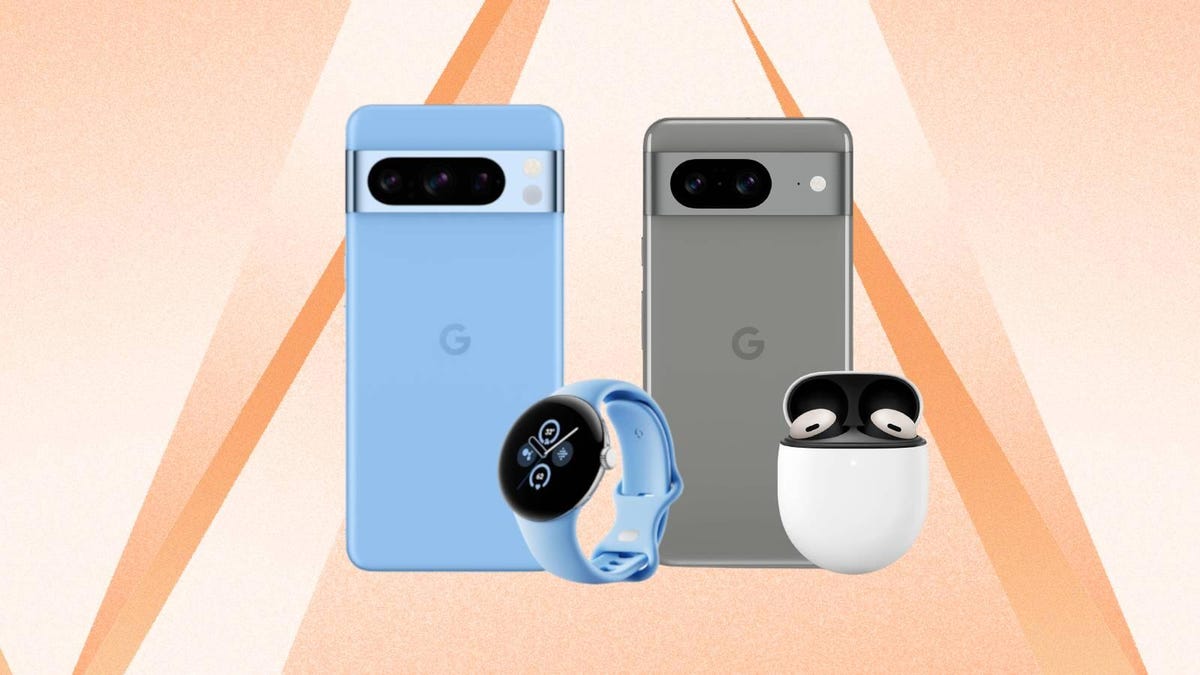
Preorder the Google Pixel 8 or 8 Pro at Amazon and Get a Freebie With Your Purchase
The new flagships of the Pixel lineup, the Google Pixel 8 and 8 Pro, are nearly here, and Google fans are champing at the bit to get their hands on one. Preorders have launched and right now Amazon is sweetening the deal. Not only is the company slashing the price of the Pixel 8 and 8 Pro by up to 25%, but it’s also adding a freebie onto your purchase. You’ll get a set of Pixel Buds Pro with the purchase of the base Pixel 8 or a new Pixel Watch 2 when you preorder the Pixel 8 Pro, absolutely free.
With new and exciting features such as an ultrawide camera with bigger and better sensor, a telephoto lens, and more, this new flagship lineup from Google seems like a solid upgrade for most people (though our full review is still in process). The company is also boasting its generous seven-year span of updates and support, which is two years longer than what the preceding lineup offered and longer than what most of Google’s top competitors offer as well.
You can preorder the base model of the Google Pixel 8 with128GB of storage for $699. It’ll come with a pair of Pixel Buds Pro at no extra charge, saving you $200. Or upgrade to the version with 256GB of storage for only $60 more, and you’ll still be able to get those free earbuds — now enhanced with better features.
And for folks who want to spring for the Pro, the 128GB model of the Google Pixel 8 Pro comes with a free Pixel Watch 2, the brand-new generation of Pixel’s popular smartwatch, for just $999, which saves you a total of $350. Or upgrade to the 256GB version for $60 more. There’s even a 512GB version available for $1,179.
The new Pixel phones will be released Oct. 12. Be sure to check out our roundup for more preorder deals on the Google Pixel 8 and 8 Pro.
Best October Prime Day Deals on Earbuds and Headphones
Amazon may be calling its October sale “Prime Big Deal Days,” but it’s really just another version of Prime Day that’s in October instead of July. While the official start for this autumnal edition of Prime Day is Tuesday, Oct. 10 — it runs through Wednesday, Oct. 11 — we’re already seeing early Prime deals on certain headphones and earbuds. And some of those deals are indeed big.
Here’s a look at the best deals we’ve spotted so far (we’ve tested all the models we’re highlighting). We’ll be adding more great Prime Day headphones and earbuds deals as they hit Amazon.
Read more: Best Wireless Earbuds for 2023
Best Prime Day wireless headphones and earbuds deals
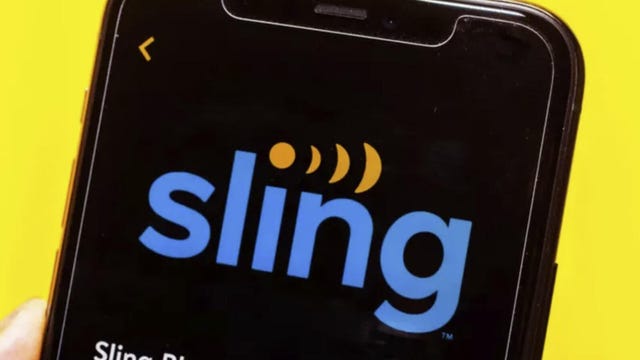
Thursday Night Football: How to Watch, Stream Bears vs. Commanders Tonight on Prime Video or Twitch
There is hope in Washington. Not in the House of Representatives, which is in complete disarray, but with the professional football team. The Commanders are in their first year under new owner Josh Harris after the unpopular (to put it kindly) Daniel Snyder was pressured to sell the team. The Commanders hung with the Eagles for 60 minutes last week before falling in overtime, with second-year QB Sam Howell looking the part and moving the offense.
The picture is less rosy for the professional football team from Chicago. The Bears are still searching for their first win of the year, but third-year QB Justin Fields looked better in last week’s loss than he did over the first three games, in which the Bears’ offense struggled mightily.
Kickoff for the Bears-Commanders game on Thursday Night Football is set for 8:15 p.m. ET (5:15 p.m. PT) tonight with the game streaming nationally on Prime Video and for free on Twitch.

Keep reading to see your options for watching Thursday Night Football on Prime Video, Twitch, NFL Plus and — if you live in the home markets of the Bears or Commanders — a local network channel.
With YouTube and YouTube TV now the exclusive home of NFL Sunday Ticket, along with games also streaming on Paramount Plus, Peacock and ESPN Plus, there’s lots for NFL fans to keep track of this season. Check out our picks for the best live TV streaming services for NFL fans in 2023.
TNF Streaming: Prime Video, Twitch and NFL Plus
Thursday Night Football games are streamed nationally on Amazon Prime Video, giving NFL fans more incentive than free two-day shipping to for $15 a month or $139 a year. You can also subscribe only to for $9 a month.
Fans in the local market of each team playing on Thursday night will be able to watch on an over-the-air station, while those who don’t pay for either of Amazon’s services can watch for free on Prime Video’s Twitch channel (Twitch is also owned by Amazon).
If you subscribe to NFL Plus, the league’s $7-per-month streaming service (or $15 a month with Red Zone included), you can also stream the game without subscribing to Prime or Prime Video. Note that NFL Plus viewing is limited to watching on just a phone or tablet, not on a computer or TV.
Can I watch Thursday Night Football on local TV?
Yes, you can, if you live in the local market of either of the teams playing on Thursday. For this week, that’s WFLD Fox 32 in Chicago and WTTG Fox 5 in Washington. There are two ways to watch local channels on your TV. The first is with a live TV streaming service. And the second is with an over-the-air antenna, if you live in an area that has good reception.
All five of the live TV streaming services carry Fox, but not every service carries every local network, so check each one using the links below to make sure it carries Fox in your particular area.
All the live TV streaming services above offer free trials, allow you to cancel anytime and require a solid internet connection. Looking for more information? Check out our live TV streaming services guide.
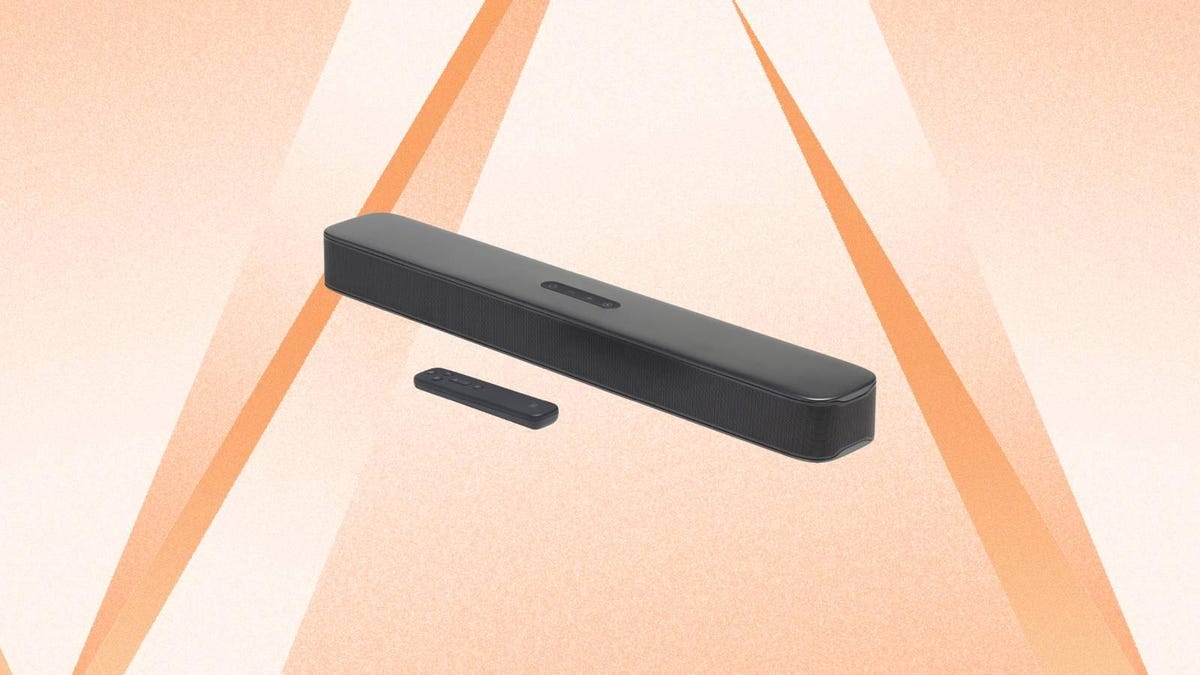
This Sneaky Discount Saves You Over $100 on a JBL 2.0 Soundbar
You don’t need a complicated or expensive surround sound setup to improve your TV’s audio. The JBL Bar 2.0 All-in-One soundbar is simple and compact solution that can bring powerful and immersive sound to your home movie nights, and right now you can pick it up at a serious discount. Though you won’t see any savings listed at Harman Audio, the price will automatically drop to just $82 when you add it to your cart, which saves you a whopping $118 compared to the usual price. But there’s no set expiration for this low-key offer, so we’d recommend taking advantage of it sooner rather than later if you don’t want to miss out on these savings.
This 2.0-channel JBL soundbar delivers some serious sound for a single-piece setup. It boasts 80W of total output power, and is equipped with two full-range drivers for crisp highs and deep, rich lows. Plus, it features a Dolby Digital decoder to emulate multichannel audio for a truly immersive and cinematic watch experience. It also has built-in Bluetooth for easy wireless music streaming from your phone, laptop or other devices. Plus, it’s incredibly easy to setup with both an HDMI ARC port and an optical cable connection.
And if you’re in the market for a different model, you can check out our full roundup of all the best soundbar deals for even more bargains.
Best October Prime Day Phone Deals You Can Shop Right Now
With October’s Prime Day event around the corner, we’re already starting to see a lot of excellent Prime Day deals on phones across pretty much all brands. So, if you’ve been wanting to buy a new phone, now is the perfect time to start looking, and we’ve collected some of our favorite deals across the board.
We’ve done our best to find deals that align with our own favorite phones, such as phones from our best phones under $300 and best phones overall lists. As such, we’re fairly confident with all the phones we’ve suggested below; whether they’re ultra-budget friendly or higher-end flagship phones, you’ll find a good phone with a great price. We’ve also focused primarily on unlocked phones that will work on all US carriers, and noted where carrier service is required to get the deal.
Best Prime Day Phone Deals
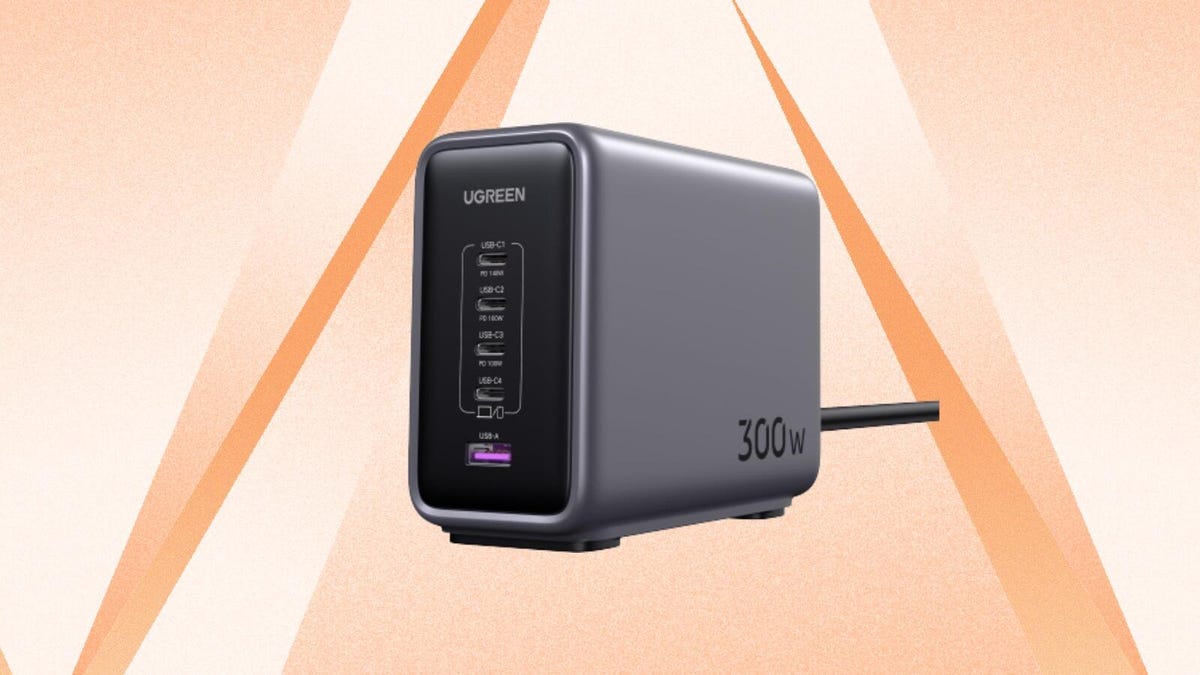
Charge Your iPhone 15 and More With This 300W Ugreen USB-C Charger at $70 Off
Charging all of your devices at once can sometimes mean having multiple plugs in play, but what if you could charge everything off of one single outlet and still have enough juice for even the most thirsty of gaming laptops? The Ugreen Nexode 300-watt charger is the answer, and right now it’s yours for just $200. Got a new USB-C iPhone 15 that needs charging? This is a good place to start.
This charger would normally cost around $270, but if you order now you’ll save a sizable 26% ($70) without having to do anything special. The charger itself is available for quick delivery via Amazon and you could be powering all of your laptops, phones and more as soon as tomorrow.
When it comes to USB-C chargers, Ugreen is one of the names that often springs to mind. The company makes plenty of chargers of different shapes and sizes, and this 300-watt monster sits at the top of the tree. It has five ports with a maximum 140 watts available via a single USB-C port. That’s enough to charge even the most powerful of laptops, but you can also charge multiple devices at once without compromising on speed. Two USB-C ports can be used to deliver 100 watts to one laptop and 140 watts to another, for example. Even if you use all five ports, you can still charge one device at the full 140 watts.
All of this comes in a box with a 240-watt USB-C cable to get you started, so you can be up and charging in no time at all.
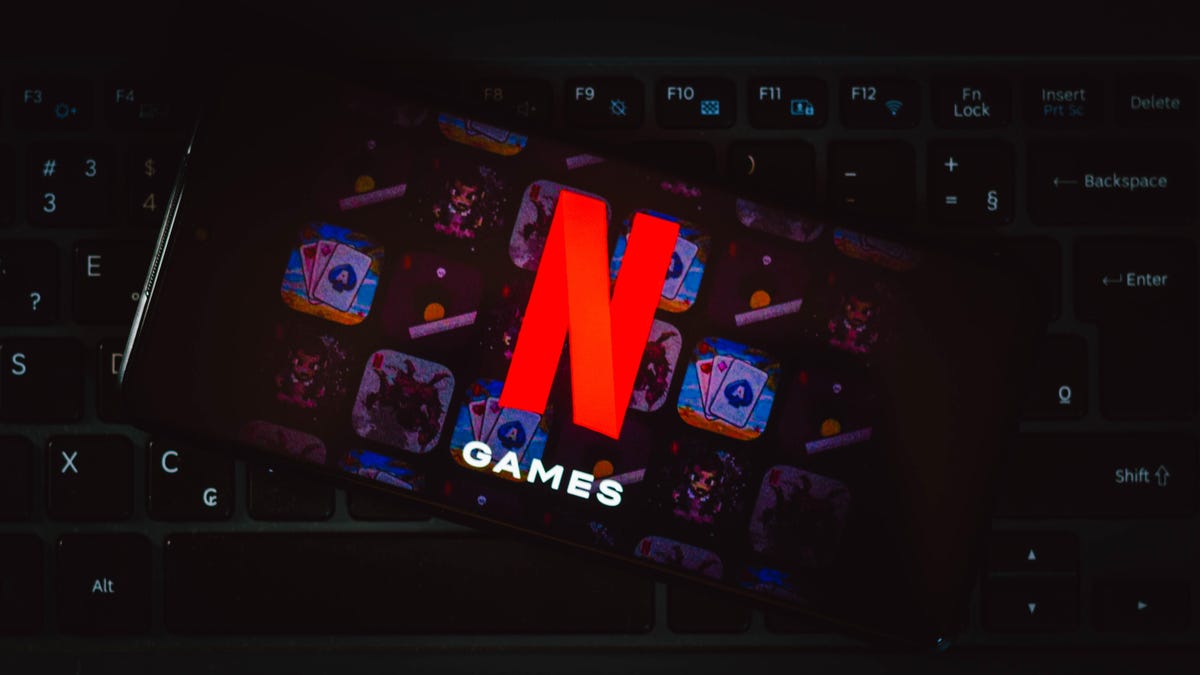
Celebrate Spooky Season With These Upcoming Netflix Games Titles
Netflix, a CNET Editors’ Choice Award pick, is virtually synonymous with streaming TV shows and movies. On top of letting you stream shows like Black Mirror and Stranger Things, your subscription gives you access to a library of mobile games you can play on your iOS or Android device.
In October, Netflix Games is adding two spooky games for you to play in time for Halloween. Both will be added to Netflix’s gaming library throughout the month, but exact dates aren’t yet known.
Here are the titles Netflix Games is adding in October.
Dead Cells: Netflix Edition

Dead Cells, the award winning roguelike platformer, is bringing its action to Netflix. You might object that it isn’t really a horror or Halloween-themed game, but it does have “dead” in the title (and you’ll die… a lot). In this game, your character has to fight through creatures and dungeons to slay the king. And if your character dies, no worries, it’s all part of the experience. Death unlocks more powers for your character and allows you to learn the right pattern to defeat your enemies. There’s a reason the game’s tagline is “Kill, die, learn, repeat.”
Slayaway Camp: Netflix and Kill
This Netflix Games exclusive is a puzzle title where you take control of a killer named Skullface — naturally. Skullface is loose at a summer camp, and like any good killer at a summer camp, he kills camp counselors in myriad ways, like squishing and decapitating them. It’s your job to slide Skullface around the stage to get rid of the camp counselors in as few moves as possible.
Here’s how you can access games in Netflix’s library.
1. Download the Netflix app onto your iPhone, iPad or Android device.
2. Open the Netflix app and sign in to your account.
3. Scroll down your homepage until you see the Mobile Games carousel.
4. Tap into a game to learn more about it.
5. Tap Get Game to download a game you’re interested in.
An additional pop-up from either Apple’s App Store or the Google Play store will open, asking if you want to download the game. After you’ve confirmed that action, the game will start downloading on your device, like other apps.
For more, check out other Netflix Games titles, like Oxenfree 2, WrestleQuest and The Queen’s Gambit Chess.
